-
Countries
-
Data and Analysis
-
Special Focus
-
Crisis Responses
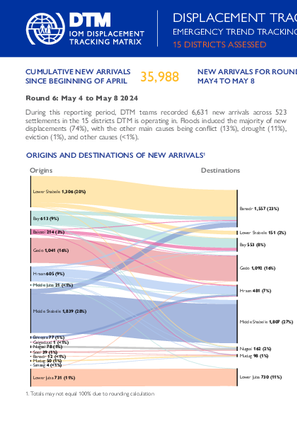
Contact
DTM Somalia, IOMSomaliaDTM@iom.int
Language
English
Location
Somalia
Period Covered
May 04 2024
May 08 2024
Activity
- Mobility Tracking
- Baseline Assessment
This latest round of Emergency Trends Tracking was initiated in April 2024 to monitor displacements movements during the Gu rainy season. Districts covered in this round include Afgooye, Afmadow, Baardheere, Baidoa, Balcad, Belet Weyne, Dayniile, Gaalkacyo, Garoowe, Hodan, Jamaame, Jowhar, Kahda, Kismaayo, Luuq.
ETT is a crisis-based tool that tracks sudden displacement triggered by specific events or emerging crises. The objective of ETT is to help prioritize humanitarian response and to enable partners to deliver rapid assistance. Based on previous shock induced displacement patterns, the humanitarian community expects that people will continue to move toward urban areas in search of humanitarian services. Consequently, the ETT coverage focuses on the main urban centers and surrounding villages for each assessed district. The data is collected through Key Informant Interviews (KIIs) at the location level, from Sunday to Wednesday every week. It includes information on new arrivals, numbers and demographic of IDPs, reasons for displacement, intentions, humanitarian assistance and priority needs among others.
The ETT tool also adapts to regional contexts: because of the very high number of IDP sites in Khada and Daynile districts in Banadir region and in Baidoa district in Bay region, a zonal approach has been adopted for these areas. Each week, KIIs are first conducted at the zone level to indicate to the field teams which locations have received the most new arrivals and which need to be assessed. To facilitate the joint analysis of the CCCM (Camp Coordination and Camp Management) Cluster’s New Arrivals Tracker (NAT) and ETT data, the assistance and needs indicators are identical in both tools.
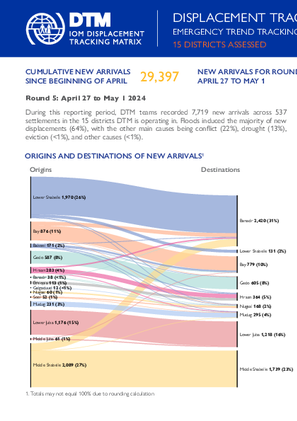
Contact
DTM Somalia, IOMSomaliaDTM@iom.int
Language
English
Location
Somalia
Period Covered
Apr 27 2024
May 01 2024
Activity
- Mobility Tracking
- Baseline Assessment
This latest round of Emergency Trends Tracking was initiated in April 2024 to monitor displacements movements during the Gu rainy season. Districts covered in this round include Afgooye, Afmadow, Baardheere, Baidoa, Balcad, Belet Weyne, Dayniile, Gaalkacyo, Garoowe, Hodan, Jamaame, Jowhar, Kahda, Kismaayo, Luuq.
ETT is a crisis-based tool that tracks sudden displacement triggered by specific events or emerging crises. The objective of ETT is to help prioritize humanitarian response and to enable partners to deliver rapid assistance. Based on previous shock induced displacement patterns, the humanitarian community expects that people will continue to move toward urban areas in search of humanitarian services. Consequently, the ETT coverage focuses on the main urban centers and surrounding villages for each assessed district. The data is collected through Key Informant Interviews (KIIs) at the location level, from Sunday to Wednesday every week. It includes information on new arrivals, numbers and demographic of IDPs, reasons for displacement, intentions, humanitarian assistance and priority needs among others.
The ETT tool also adapts to regional contexts: because of the very high number of IDP sites in Khada and Daynile districts in Banadir region and in Baidoa district in Bay region, a zonal approach has been adopted for these areas. Each week, KIIs are first conducted at the zone level to indicate to the field teams which locations have received the most new arrivals and which need to be assessed. To facilitate the joint analysis of the CCCM (Camp Coordination and Camp Management) Cluster’s New Arrivals Tracker (NAT) and ETT data, the assistance and needs indicators are identical in both tools.
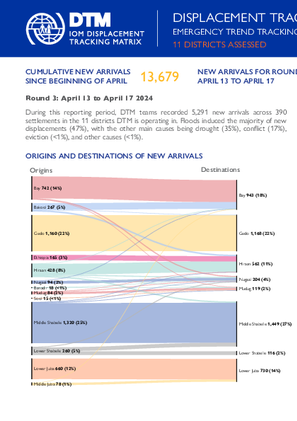
Contact
DTM Somalia, IOMSomaliaDTM@iom.int
Language
English
Location
Somalia
Period Covered
Apr 13 2024
Apr 17 2024
Activity
- Mobility Tracking
- Baseline Assessment
This latest round of Emergency Trends Tracking was initiated in April 2024 to monitor displacements movements during the Gu rainy season. Districts covered in this round include Afgooye, Afmadow, Baardheere, Baidoa, Balcad, Belet Weyne, Gaalkacyo, Garoowe, Jowhar, Kismaayo, and Luuq.
ETT is a crisis-based tool that tracks sudden displacement triggered by specific events or emerging crises. The objective of ETT is to help prioritize humanitarian response and to enable partners to deliver rapid assistance. Based on previous shock induced displacement patterns, the humanitarian community expects that people will continue to move toward urban areas in search of humanitarian services. Consequently, the ETT coverage focuses on the main urban centers and surrounding villages for each assessed district. The data is collected through Key Informant Interviews (KIIs) at the location level, from Sunday to Wednesday every week. It includes information on new arrivals, numbers and demographic of IDPs, reasons for displacement, intentions, humanitarian assistance and priority needs among others.
The ETT tool also adapts to regional contexts: because of the very high number of IDP sites in Khada and Daynile districts in Banadir region and in Baidoa district in Bay region, a zonal approach has been adopted for these areas. Each week, KIIs are first conducted at the zone level to indicate to the field teams which locations have received the most new arrivals and which need to be assessed.
To facilitate the joint analysis of the CCCM (Camp Coordination and Camp Management) Cluster’s New Arrivals Tracker (NAT) and ETT data, the assistance and needs indicators are identical in both tools.
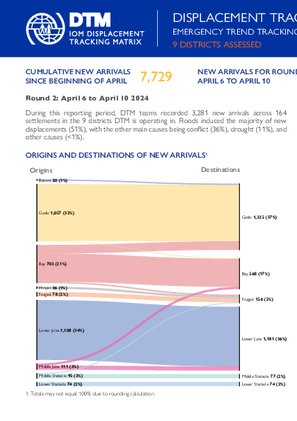
Contact
DTM Somalia, IOMSomaliaDTM@iom.int
Language
English
Location
Somalia
Period Covered
Apr 06 2024
Apr 10 2024
Activity
- Mobility Tracking
- Baseline Assessment
This latest round of Emergency Trends Tracking was initiated in April 2024 to monitor displacements movements during the Gu rainy season. Districts covered in this round include Afgooye, Afmadow, Baardheere, Baidoa, Balcad, Garoowe, Jamaame, Kismaayo, and Luuq.
ETT is a crisis-based tool that tracks sudden displacement triggered by specific events or emerging crises. The objective of ETT is to help prioritize humanitarian response and to enable partners to deliver rapid assistance. Based on previous shock induced displacement patterns, the humanitarian community expects that people will continue to move toward urban areas in search of humanitarian services. Consequently, the ETT coverage focuses on the main urban centers and surrounding villages for each assessed district. The data is collected through Key Informant Interviews (KIIs) at the location level, from Sunday to Wednesday every week. It includes information on new arrivals, numbers and demographic of IDPs, reasons for displacement, intentions, humanitarian assistance and priority needs among others. To facilitate the joint analysis of the CCCM (Camp Coordination and Camp Management) Cluster’s New Arrivals Tracker (NAT) and ETT data, the assistance and needs indicators are identical in both tools.
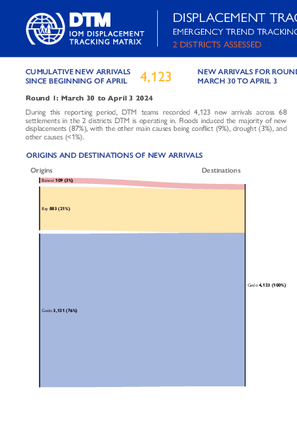
Contact
DTM Somalia, IOMSomaliaDTM@iom.int
Language
English
Location
Somalia
Period Covered
Mar 30 2024
Apr 03 2024
Activity
- Mobility Tracking
- Baseline Assessment
This latest round of Emergency Trends Tracking was initiated in April 2024 to monitor displacements movements during the Gu rainy season. Districts covered in this round include Baardheere and Luuq.
ETT is a crisis-based tool that tracks sudden displacement triggered by specific events or emerging crises. The objective of ETT is to help prioritize humanitarian response and to enable partners to deliver rapid assistance. Based on previous shock induced displacement patterns, the humanitarian community expects that people will continue to move toward urban areas in search of humanitarian services. Consequently, the ETT coverage focuses on the main urban centers and surrounding villages for each assessed district. The data is collected through Key Informant Interviews (KIIs) at the location level, from Sunday to Wednesday every week. It includes information on new arrivals, numbers and demographic of IDPs, reasons for displacement, intentions, humanitarian assistance and priority needs among others. To facilitate the joint analysis of the CCCM (Camp Coordination and Camp Management) Cluster’s New Arrivals Tracker (NAT) and ETT data, the assistance and needs indicators are identical in both tools.

Contact
DTM Europe, DTMMediterranean@iom.int
Language
English
Location
Slovakia
Period Covered
Jan 01 2024
Mar 31 2024
Activity
- Survey
- Return Intention
- Flow Monitoring
IOM’s Displacement Tracking Matrix (DTM) collected data on Ukrainian nationals and Third-Country Nationals (TCNs) that crossed back to Ukraine from or through Slovakia, either temporarily or permanently. The survey focuses on the return intentions, duration of displacement, destinations, assistance, and experiences of discrimination of respondents. A total of 1,335 surveys were collected between January and March 2024.
Key findings:
- 27% of Ukrainian respondents intend to stay in Ukraine (prospective returnees), while 68% plan to go for a short visit.
- The share of those intending to return to Ukraine is higher among men than women (49% vs 25%). Women are more likely to be crossing into Ukraine for a short visit than men (69% vs 44%).
- Most of the short-term visitors plan to stay in their own home in Ukraine (78% overall), while others report to be going to their relatives’ homes (10%), finding other private solutions (7%) or staying with friends (4%). The share of those planning to stay at home is higher among prospective returnees (98%) than among short-term visitors (78%).
- Reasons for returning for prospective returnees include: visit relatives or close friends (75%), meet with family members (6%), reunite with their family (6%).
- Reasons for returning for short-term visitors include: visit family members (76%), healthcare (26%), reunite with family (21%).
- 64% of the Ukrainian nationals originate from seven regions in Ukraine: Zakarpatska (21%), Kyiv (13%), Kharkivska (8%), Dnipropetrovska (8%), Odeska (6%), Zaporizka (3%), and Mykolaivska (3%). The remaining 36% of respondents come from another 20 regions across Ukraine.
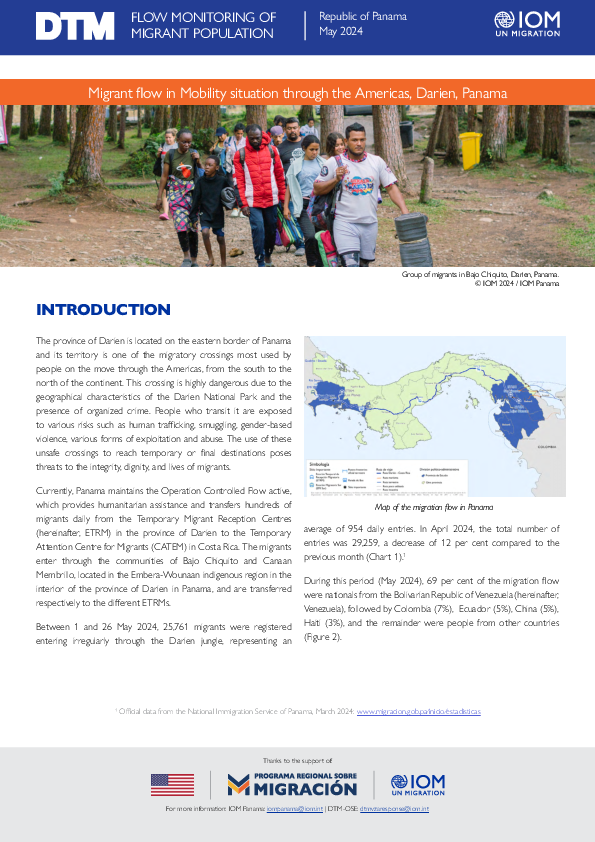
Contact
Idiam Osorio, iosorio@iom.int
Language
English
Location
Panama
Period Covered
May 01 2024
May 26 2024
Activity
- Flow Monitoring Survey
- Flow Monitoring
The province of Darien is located on the eastern border of Panama and its territory is one of the migratory crossings most used by people on the move through the Americas, from the south to the north of the continent. This crossing is highly dangerous due to the geographical characteristics of the Darien National Park and the presence of organized crime. People who transit it are exposed to various risks such as human trafcking, smuggling, gender-based violence, various forms of exploitation and abuse. The use of these unsafe crossings to reach temporary or fnal destinations poses threats to the integrity, dignity, and lives of migrants.
Currently, Panama maintains the Operation Controlled Flow active, which provides humanitarian assistance and transfers hundreds of migrants daily from the Temporary Migrant Reception Centres (hereinafter, ETRM) in the province of Darien to the Temporary Attention Centre for Migrants (CATEM) in Costa Rica. The migrants enter through the communities of Bajo Chiquito and Canaan Membrillo, located in the Embera-Wounaan indigenous region in the interior of the province of Darien in Panama, and are transferred respectively to the diferent ETRMs.
Between 1 and 26 May 2024, 25,761 migrants were registered entering irregularly through the Darien jungle, representing an average of 954 daily entries. In April 2024, the total number of entries was 29,259, a decrease of 12 per cent compared to the previous month.

Contact
Contact mtmTajikistan@iom.int
Language
English
Location
Tajikistan
Period Covered
Jan 01 2023
Dec 31 2023
Activity
- Flow Monitoring
- Mobility Tracking
The report aims to provide an overview of the migration patterns and mobility in Tajikistan, drawing upon data from the latest available sources until the end of 2023 from national and international datasets on migratory movements concentrating on the most recent migration situation in Tajikistan. This includes migration flow, number of residences permits and remittances, as well as reasons for migration. The report includes the continuing impact of the Russian invasion of Ukraine on traditional migration corridors in the region, changing labour migration flows, increase of climate change and migration concerns, the growing urbanization process, the social-economic circumstances, and other major events are described as main contributing factors of the human mobility and migratory movements in the given period in the country.
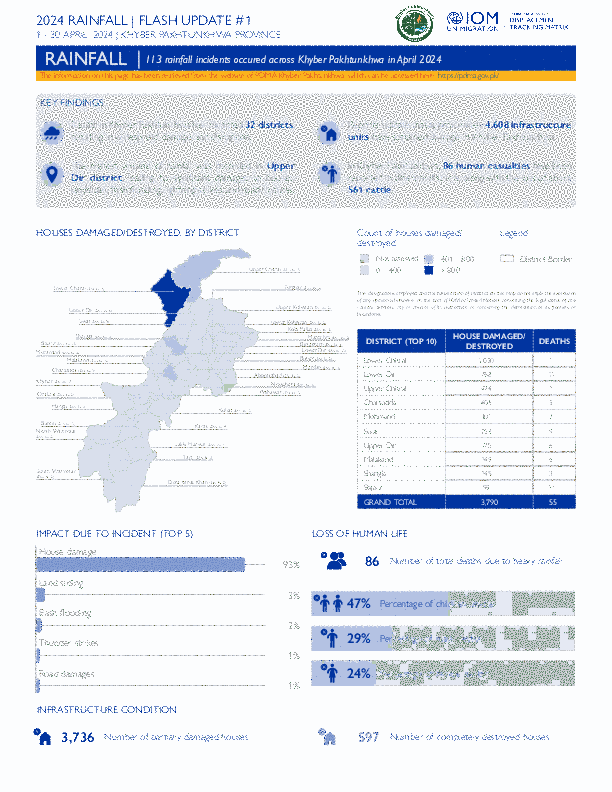
Contact
DTMPakistan@iom.int
Language
English
Location
Pakistan
Period Covered
Apr 01 2024
Apr 30 2024
Activity
- Event Tracking
Rainfall in Khyber Pakhtunkhwa has impacted 32 districts, resulting in widespread damage and disruption. Reports indicate that approximately 4,608 infrastructure units have sustained damage in Khyber Pakhtunkhwa. The highest volume of rainfall was recorded in Upper Dir district, leading to significant damages to houses, landslides, flash flooding, lightning strikes, and road closures. In Khyber Pakhtunkhwa, 86 human casualties have been reported in different districts, along with the loss of about 561 cattle.
Jun 06 2024
Print
Since the start of heavy rainfall from April 2024 in various parts of Pakistan, Khyber Pakhtunkhwa (KP), and Balochistan have been most affected. This operation gives an overview of the affected districts, the extent of the damages to houses and infrastructure, as well as the loss of human life and livestock.
Countries in this response
- Active DTM operation
- Past DTM operation
